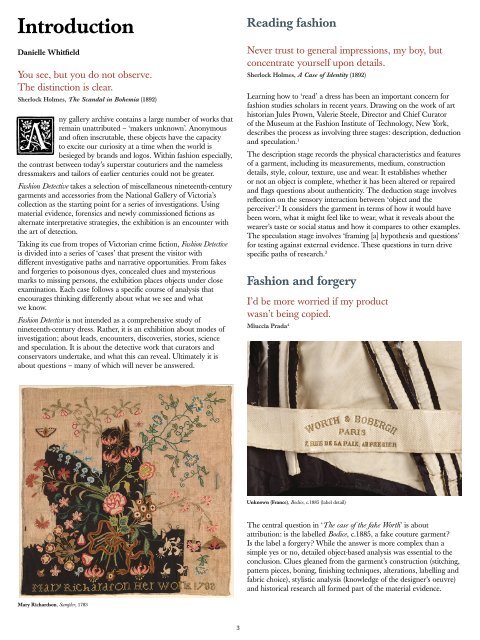FASHION-DETECTIVE
FASHION-DETECTIVE
FASHION-DETECTIVE
You also want an ePaper? Increase the reach of your titles
YUMPU automatically turns print PDFs into web optimized ePapers that Google loves.
Introduction<br />
Danielle Whitfield<br />
You see, but you do not observe.<br />
The distinction is clear.<br />
Sherlock Holmes, The Scandal in Bohemia (1892)<br />
ny gallery archive contains a large number of works that<br />
remain unattributed – ‘makers unknown’. Anonymous<br />
and often inscrutable, these objects have the capacity<br />
to excite our curiosity at a time when the world is<br />
besieged by brands and logos. Within fashion especially,<br />
the contrast between today’s superstar couturiers and the nameless<br />
dressmakers and tailors of earlier centuries could not be greater.<br />
Fashion Detective takes a selection of miscellaneous nineteenth-century<br />
garments and accessories from the National Gallery of Victoria’s<br />
collection as the starting point for a series of investigations. Using<br />
material evidence, forensics and newly commissioned fictions as<br />
alternate interpretative strategies, the exhibition is an encounter with<br />
the art of detection.<br />
Taking its cue from tropes of Victorian crime fiction, Fashion Detective<br />
is divided into a series of ‘cases’ that present the visitor with<br />
different investigative paths and narrative opportunities. From fakes<br />
and forgeries to poisonous dyes, concealed clues and mysterious<br />
marks to missing persons, the exhibition places objects under close<br />
examination. Each case follows a specific course of analysis that<br />
encourages thinking differently about what we see and what<br />
we know.<br />
Fashion Detective is not intended as a comprehensive study of<br />
nineteenth-century dress. Rather, it is an exhibition about modes of<br />
investigation; about leads, encounters, discoveries, stories, science<br />
and speculation. It is about the detective work that curators and<br />
conservators undertake, and what this can reveal. Ultimately it is<br />
about questions – many of which will never be answered.<br />
Reading fashion<br />
Never trust to general impressions, my boy, but<br />
concentrate yourself upon details.<br />
Sherlock Holmes, A Case of Identity (1892)<br />
Learning how to ‘read’ a dress has been an important concern for<br />
fashion studies scholars in recent years. Drawing on the work of art<br />
historian Jules Prown, Valerie Steele, Director and Chief Curator<br />
of the Museum at the Fashion Institute of Technology, New York,<br />
describes the process as involving three stages: description, deduction<br />
and speculation. 1<br />
The description stage records the physical characteristics and features<br />
of a garment, including its measurements, medium, construction<br />
details, style, colour, texture, use and wear. It establishes whether<br />
or not an object is complete, whether it has been altered or repaired<br />
and flags questions about authenticity. The deduction stage involves<br />
reflection on the sensory interaction between ‘object and the<br />
perceiver’. 2 It considers the garment in terms of how it would have<br />
been worn, what it might feel like to wear, what it reveals about the<br />
wearer’s taste or social status and how it compares to other examples.<br />
The speculation stage involves ‘framing [a] hypothesis and questions’<br />
for testing against external evidence. These questions in turn drive<br />
specific paths of research. 3<br />
Fashion and forgery<br />
I’d be more worried if my product<br />
wasn’t being copied.<br />
Miuccia Prada 4<br />
Unknown (France), Bodice, c.1885 (label detail)<br />
The central question in ‘The case of the fake Worth’ is about<br />
attribution: is the labelled Bodice, c.1885, a fake couture garment?<br />
Is the label a forgery? While the answer is more complex than a<br />
simple yes or no, detailed object-based analysis was essential to the<br />
conclusion. Clues gleaned from the garment’s construction (stitching,<br />
pattern pieces, boning, finishing techniques, alterations, labelling and<br />
fabric choice), stylistic analysis (knowledge of the designer’s oeuvre)<br />
and historical research all formed part of the material evidence.<br />
Mary Richardson, Sampler, 1783<br />
3


